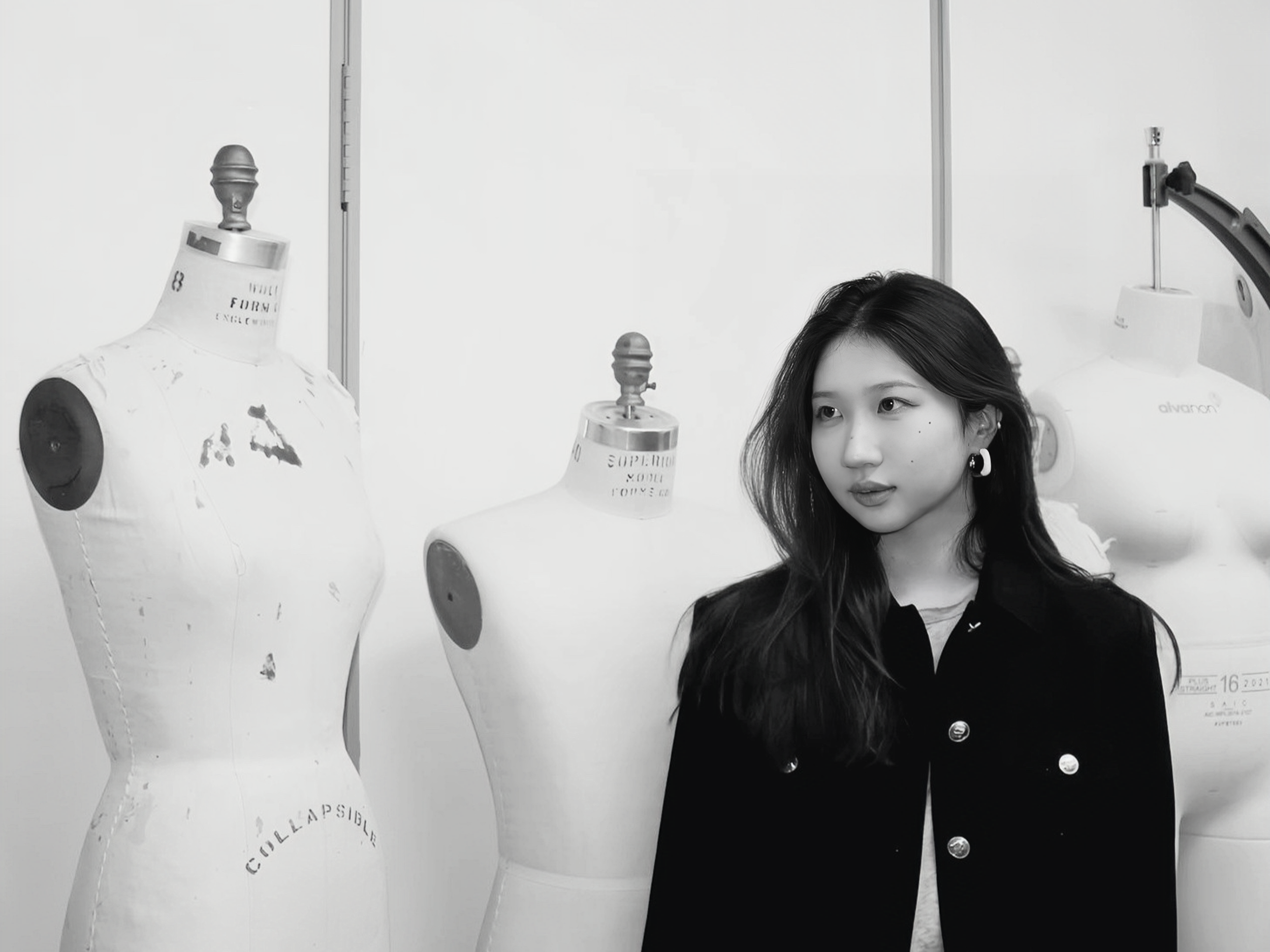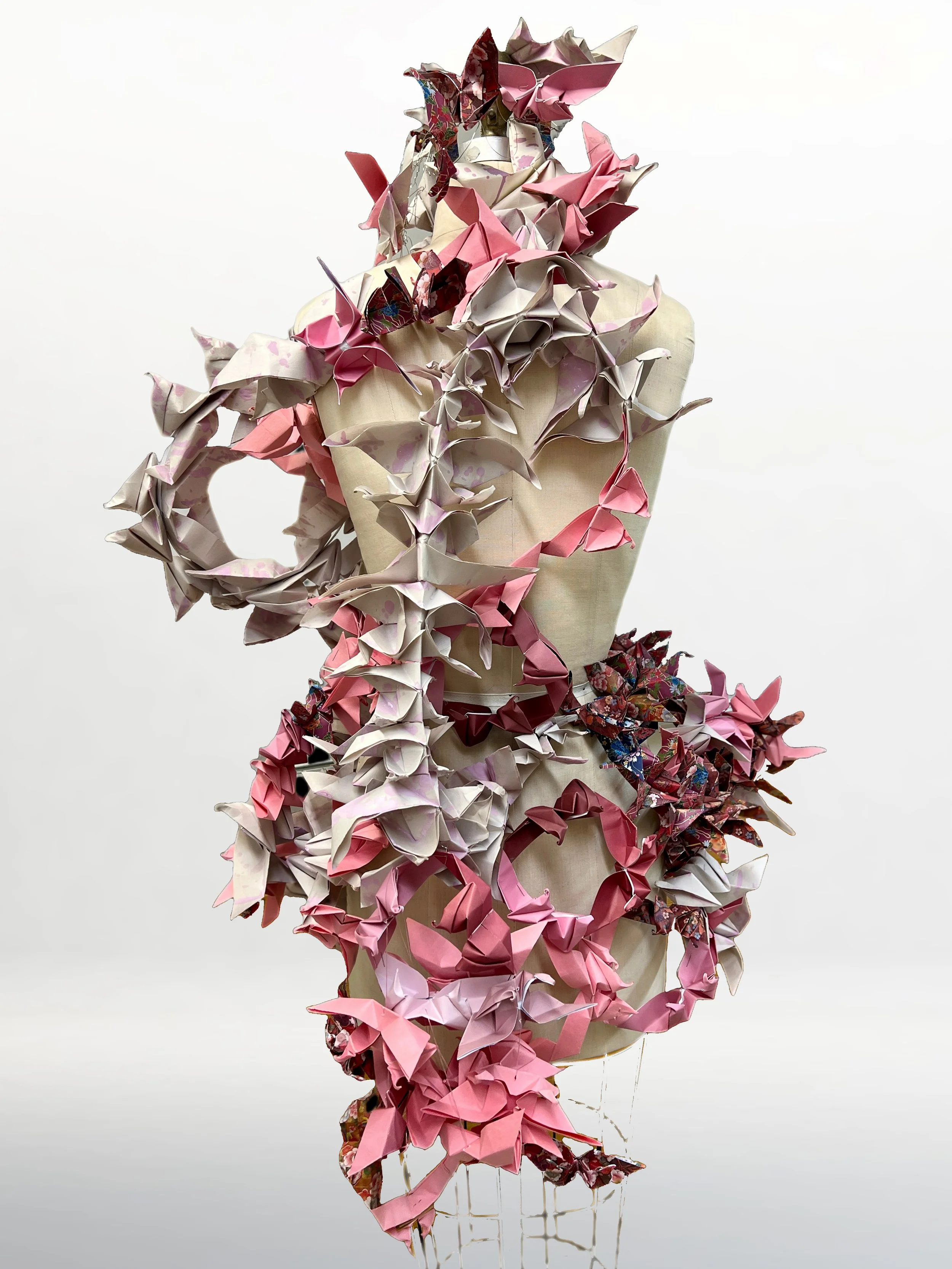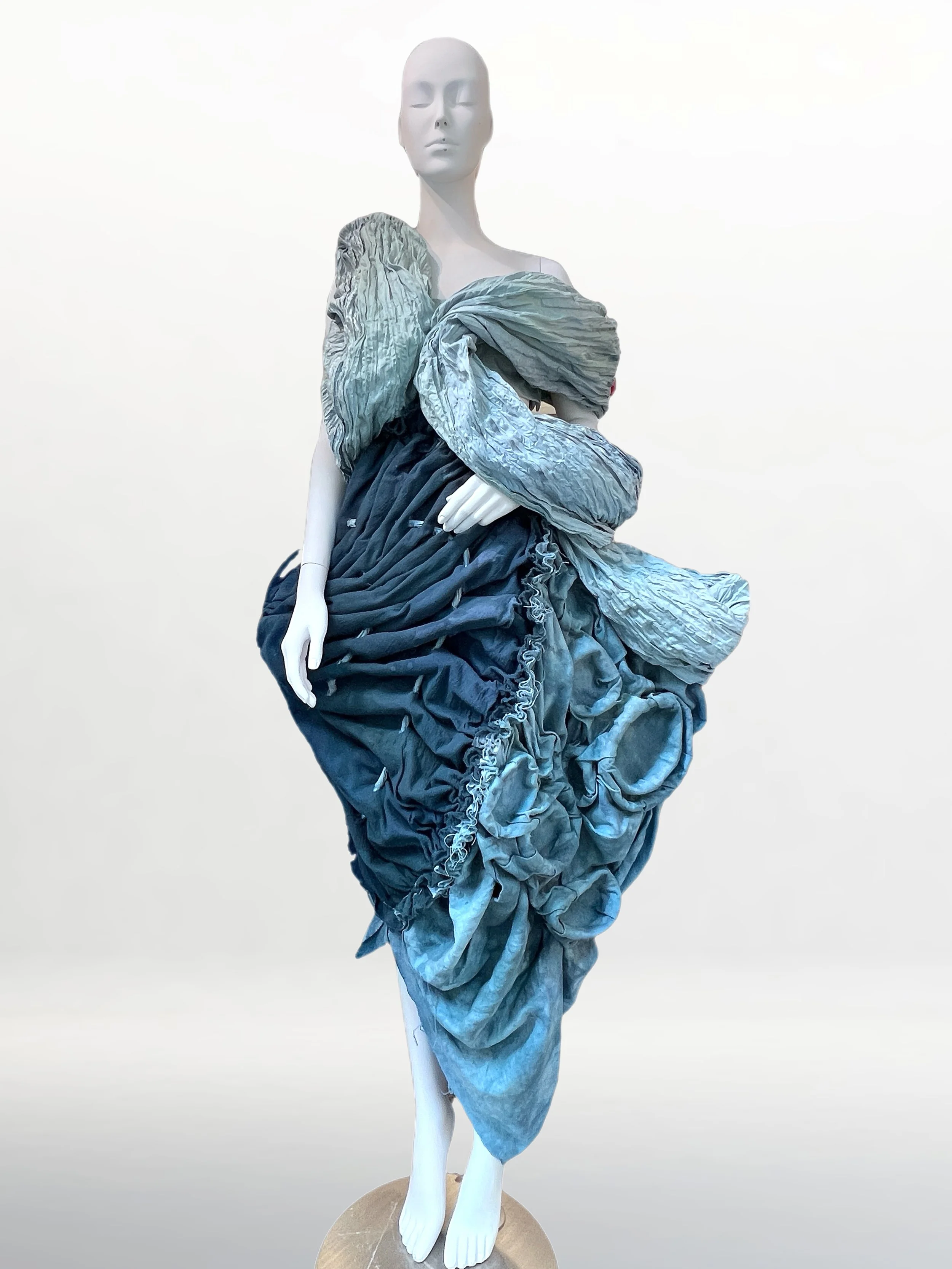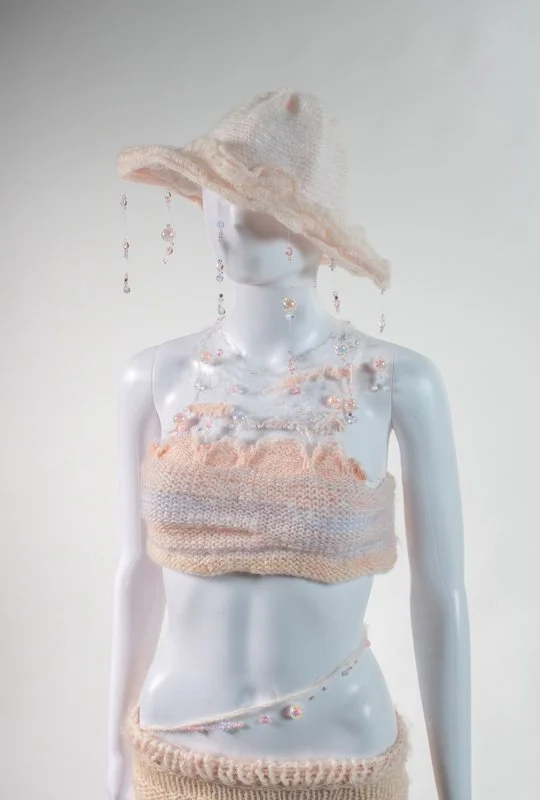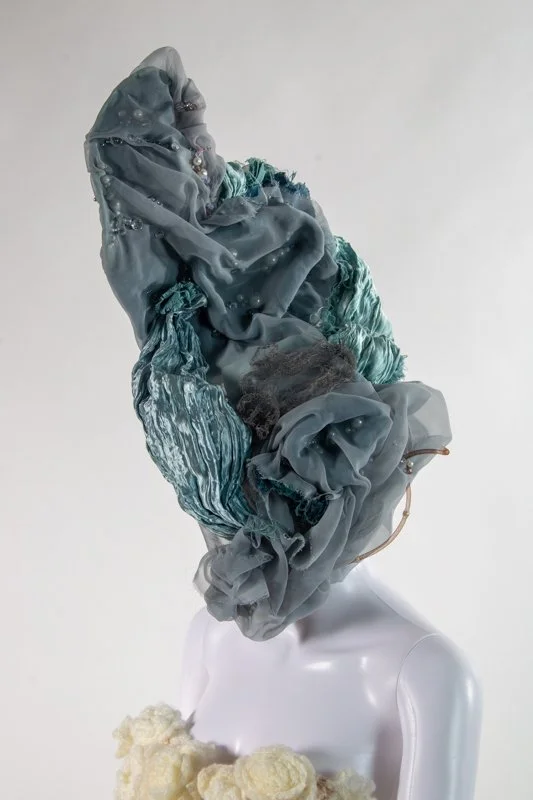10 Questions with Zeyang Xu
Zeyang Xu is a student at the School of the Art Institute of Chicago, where she is expected to graduate in 2025 with a focus on Fashion Design. She has also devoted time to exploring advanced courses in the areas of Fiber, Art History, and Painting.
Born in Hangzhou, China, Zeyang developed a passion for the fine arts at an early age, growing up in a family with deep artistic roots. Her father is an avid collector of Chinese contemporary art and has played a key role in nurturing her curiosity and encouraging her creative development. Over time, Zeyang has honed her ability to blend expressiveness with technical skill, gaining proficiency in a wide range of fashion and fibre techniques, such as pattern making, draping, textile manipulation, knitting, embroidery, weaving, crocheting, beading, and heat pressing. Alongside these techniques, she has developed her expertise in painting and sculpture, which enriches her multifaceted creative perspective. This diverse skill set empowers her to professionally navigate the entire creative process, from concept development to the execution of designs, with a cross-disciplinary approach that seamlessly integrates multiple mediums and original, forward-thinking ideas.
Zeyang has a strong interest in sustainable fashion and is committed to exploring eco-friendly materials to make a positive impact on the industry. She is also attuned to contemporary trends, seamlessly blending both Eastern and Western aesthetics into her works. Drawing from her diverse background, she seeks to bring a unique perspective to her creations, drawing inspiration from her personal journey of exploration, cultural fusion, and critical reflection. Her fashion design collection Wave, which combines sustainable materials with her personal and cultural experiences, received an Honorary Nomination at the Sophomore Seminar Exhibition at SAIC, further showcasing her ability to create meaningful pieces that resonate with viewers.
In addition to her design work, Zeyang has a keen interest in the art market, particularly in gallery management and curation. During her internship at Hibon Art Gallery in Hangzhou, she represented the gallery at two of China’s largest contemporary art fairs—the Beijing Contemporary Art Expo and Art Shenzhen—where she refined her skills in exhibition design and sales strategies.
Zeyang Xu is committed to expanding her creative practice, blending diverse mediums and cultural influences to create visually captivating and meaningful work. Her focus on sustainability, combined with her technical expertise and unique perspective, positions her to contribute to the evolving world of contemporary design. As she progresses in her career, Zeyang remains dedicated to challenging conventions and sparking meaningful dialogue within the art and fashion industries.
Zeyang Xu - Portrait
ARTIST STATEMENT
Zeyang Xu’s 2024 fashion design piece Wave is a deeply personal exploration of emotional balance, inspired by a jade bracelet gifted by her father in her youth. Acting as a comfort object, the bracelet symbolizes serenity and reassurance, which Xu translates into her design through fabric. The piece is primarily made from recycled materials, chosen to reflect the natural cycles that jade represents and emphasize her commitment to sustainability.
The garment consists of two main sections, each representing a different emotional state. The top portion, with its flowing pleats, wraps around the body like the jade bracelet—offering protection and reassurance, symbolizing serenity and emotional balance. The pleats naturally flow downward, seamlessly connecting to the bottom section while maintaining the fluidity of the design.
The bottom section of the garment is divided into two parts, reflecting the duality of Yin and Yang. One side, with tightly gathered fabric, embodies the turbulence and emotional unrest of Yin—restless, shadowy, and melancholic. The other side, with smoother folds and circular elements, symbolizes the calming, grounding qualities of Yang—balanced, calm, and reassuring. These contrasting sections merge at a wavy line, representing the transition between Yin and Yang, where the colours collide and blend to mirror the emotional journey from turmoil to tranquillity.
The creation process of Wave began with dyeing and manipulating the fabric to capture the flow of emotion. Xu blended shades of blue-green, purple, and grey, drawing inspiration from both her intended emotional expression and the subtle hues of jade. Using tie-dye techniques, pleating, and heat manipulation, she conveyed the unpredictable nature of emotions, transitioning from the chaos of Yin to the tranquillity of Yang. Xu also incorporated horsehair and sponge beneath the fabric to form raised circular shapes inspired by the suction cups of an octopus. These three-dimensional textures symbolize the jade bracelet’s calming and anchoring presence, evoking both the secure grip of the octopus suckers and the comforting embrace of the bracelet.
In Wave, Zeyang Xu delves into the balance between emotional turmoil and peace, drawing from her own journey of self-discovery and growth. The piece reflects her exploration of the complexities of emotion, where conflict and serenity coexist. Through the symbolism of the jade bracelet and the interplay of contrasting textures and colours, Xu captures the fluid nature of emotions and the transformation that comes from reconciling inner struggles. The garment tells a story of personal identity, resilience, and the quiet strength found in stillness, encouraging viewers to reflect on their own emotional equilibrium and the ever-changing nature of self.
Bloom, wire, paper, 2024 © Zeyang Xu
INTERVIEW
Please introduce yourself to our readers. Who are you, and how would you define yourself as an artist?
My name is Zeyang Xu. I am originally from Hangzhou, China, and currently live in Chicago, attending the School of the Art Institute of Chicago. I will be graduating this May.
As an artist and designer, I work across fashion, textiles, and fibre art, creating pieces that explore the relationship between body, space, and emotion. Many of my works take the form of wearable art, combining the movement of clothing with a sculptural presence shaped by fabric manipulation, layering, and the way materials hold space. I am drawnto the quiet and intimate aspects of experience, to how memory can be shaped into form, how clothing can become a place for transformation, and how emotion can be expressed through texture and structure.
Growing up in a family with strong artistic roots, how did your upbringing and your father’s passion for contemporary art shape your journey?
Growing up, I spent a lot of time with my father in his art gallery in Hangzhou, surrounded by paintings, books, and conversations about art. His deep appreciation for both traditional Chinese ink painting and contemporary Chinese art exposed me to a wide visual and philosophical spectrum at an early age. I was especially drawn to artists like Shi Hu and Zeng Mi, whose very different ways of working shaped my understanding of emotion, rhythm, and balance. Shi Hu’s paintings are bold and expressive with a raw vitality, while Zeng Mi’s are quiet, restrained, and composed with a subtle poetic order.
That environment shaped the way I see and make art. It taught me to respect tradition while also encouraging me to explore, experiment, and move between different media without hesitation. More than anything, it gave me the confidence to see art not just as a career but as a way of thinking and a way of living.
Bloom, wire, paper, 2024 © Zeyang Xu
You’ve explored various disciplines, including Fashion, Fiber Art, Art History, and Painting. How have these studies influenced your approach to fashion design?
Each area has left its own mark. Studying painting helped me understand colour and rhythm. Fiber art taught me patience and structure. Art history gave me context and a sense of where things come from and why they matter. What connects them is the idea of process, the act of building something slowly, whether by hand or through thought, until it feels right.
In fashion, I am not so much interested in trends or surfaces. I think more about what it means to wear something, what it holds, and how it moves with a person. My work borrows from all these disciplines, but I try to let each project find its own way of speaking.
Your work reflects a strong commitment to sustainability. Can you share your process for integrating eco-friendly materials into your designs?
Sustainability is important to me, not only in terms of environmental responsibility but also in the way materials carry their own histories. I often work with reused or repurposed fabrics, believing that traces of their past can add depth and emotional texture to the work.
To me, sustainability also means making things with care and intention, creating objects that feel lasting not just in physical durability but also in emotional presence. I am not aiming to be perfect but to be thoughtful.
With expertise in techniques such as embroidery, weaving, and textile manipulation, how do you decide which methods to use for a particular project?
I usually start with a feeling or an image in my mind, and the techniques come from there. Some pieces need delicacy, so I turn to embroidery. Others feel heavier or more structural, so I might work with layering or folding, finding ways to build tension and movement within the fabric.
Recently, I have been working on a series of headpieces, where I am exploring millinery techniques, hand beading, wire-based structures, pleating, and lightweight fabric shaping. This project has led me to experiment with creating volume without heaviness and with building forms that interact with the body in more unexpected ways.
For me, the art of fashion is not only about realizing a design sketch. It also lies in how a project evolves through the making process. Often, the techniques I use push the work in new directions, and as I move forward, the material, the method, and the original idea shift and grow together until the piece finds its own rhythm.
Bloom, wire, paper, 2024 © Zeyang Xu
Bloom, wire, paper, 2024 © Zeyang Xu
Your designs often blend Eastern and Western aesthetics. How do you balance these influences, and how do they manifest in your work?
Growing up between different cultural environments has shaped the way I see and create. There is a quietness and symbolism in Chinese aesthetics that I deeply connect with, especially in the way nature, time, and impermanence are understood. Later, my experiences living and studying in the West offered different perspectives, but the themes I am drawn to remain the same. Across different places, I keep returning to the same ideas, how emotion can live in form, how memory can be held in space, and how the passage of time can be felt through materials.
In my work, these influences are not separated by geography. Sometimes you might see a silhouette that carries the rhythm of Chinese clothing traditions, or a construction method that draws from Western approaches to pattern making. I do not try to merge cultures in a literal way. Instead, I see them as parallel threads that weave together in the way I think and make.
The Wave collection is deeply personal and symbolic. How did the jade bracelet gifted by your father inspire the themes and design of this piece?
The jade bracelet was a very personal gift that carried not only traditional Chinese meanings and wishes but also became a comfort object for me. It stayed close, a quiet presence that moved with me through different places and stages of life. In Chinese culture, jade has long symbolized protection, warmth, and a connection to the body that feels both physical and emotional.
When I began designing Wave, I kept returning to the memory of the bracelet, thinking about its circular shape, the smoothness of its surface, and the quiet sense of movement it seemed to hold. I wanted to translate these feelings into fabric, creating a garment that could carry a sense of closeness, protection, and continuous flow. Rather than recreating the object itself, I focused on the emotions it embodied and the ways they could live within the form.
Wave, fabric, 2024 © Zeyang Xu
The contrasting sections of Wave explore Yin and Yang. How did you translate these abstract concepts into tangible design elements?
In Wave, I was interested in exploring how different emotional states can coexist within the same form. The garment is divided into two sections, each shaped by a different kind of feeling. One side is gathered more tightly, creating tension and weight that reflect restlessness, uncertainty, and the turbulence often associated with Yin. The other side unfolds more softly, with gentle folds and rounded forms that carry the grounding and calming presence of Yang.
These two parts meet along a shifting seam that moves across the body, blending and separating as the garment flows. I worked with contrasts in texture, structure, and movement to suggest how emotions are rarely fixed, and how balance is something that is always shifting rather than perfectly achieved.
Through the construction of Wave, I wanted to create a space where conflict and calm, distance and connection, can live together quietly, shaping the way the body moves and the way memory stays.
What themes, materials, or collaborations are you most excited to explore as you continue to evolve as a designer?
I am interested in continuing to explore how emotion and memory can shape not only the body but also the spaces around it. Recently, I have been thinking more about landscape, not just as a physical place but as an emotional or imagined space. I would like to create pieces that respond to specific environments, or that move between clothing, sculpture, and installation.
In terms of materials, I want to keep working with natural fibres and reused fabrics but also experiment with more delicate structures, such as lightweight wire frameworks and translucent surfaces that catch light and movement in quieter ways.
I am also looking forward to collaborating with artists in other fields. Working with dancers, poets, or ceramicists would allow me to explore how different mediums can meet through movement, texture, and shared emotional language.
Where Water Remembers (Look 1), 2025 © Zeyang Xu
Where Water Remembers (Look 4), 2025 © Zeyang Xu
Lastly, as we get closer to the end of the year, what are your plans for 2025? Do you have any new collections or projects you can tell us about?
2025 will be a year of transition. I will be returning to China after spending several years in the United States, and I am looking forward to reconnecting with familiar landscapes and people in a new way.
I am currently working on a new collection inspired by West Lake in Hangzhou, a place that has shaped many of my earliest memories. The project includes three garments and four headpieces, each drawing from the different ways water moves and holds light. In some ways, it is a continuation of the ideas I explored in Wave, still thinking about memory, place, and change, but seen through a different lens.
The collection reflects how fleeting moments can be shaped into something tangible, how the feeling of walking beside a lake at dawn or watching ripples break and reform can be carried into fabric and form. One of the headpieces is especiallyconnected to Wave, echoing its colours and emotional rhythm while moving into a new space of reflection. I am excited to continue developing this language slowly, letting memory and movement guide the work.
Artist’s Talk
Al-Tiba9 Interviews is a promotional platform for artists to articulate their vision and engage them with our diverse readership through a published art dialogue. The artists are interviewed by Mohamed Benhadj, the founder & curator of Al-Tiba9, to highlight their artistic careers and introduce them to the international contemporary art scene across our vast network of museums, galleries, art professionals, art dealers, collectors, and art lovers across the globe.


